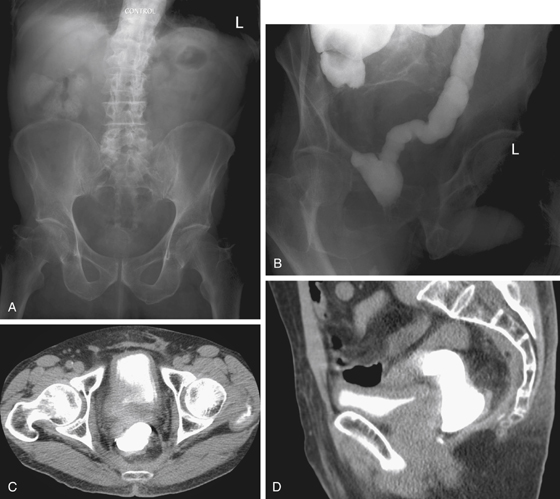CASE 75

History: A 68-year-old man underwent ultra-low anterior resection 6 months ago. He had recovered well from his surgery. Earlier today he underwent a Gastrografin enema. He is now undergoing a CT scan without intravenous contrast.
1. There is high-density material in the urinary bladder. Which of the following should be included in the differential diagnosis of this imaging finding as shown in Figures C and D? (Choose all that apply.)
C. Renal excretion of iodinated contrast administered intravascularly in the last few days
D. Vicarious renal excretion of iodinated contrast absorbed from the lumen of the intact colon
2. Several contributing factors that might increase the incidence of absorption of iodinated contrast from the colonic lumen have been recognized. Which of the following is not such a factor?
3. Apart from the diagnostic confusion, what other complication might the patient suffer from the absorption of iodinated contrast from the colonic lumen?
4. What is the most common finding on Gastrografin enema following resection for colorectal cancer with creation of diverting ileostomy?
ANSWERS
CASE 75
Vicarious Excretion
1. A, C, D, and E
2. C
3. A
4. D
References
Low VHS, Chu BK. Diagnostic error due to vicarious excretion of rectal iodinated contrast. Austral Radiol. 2006;50:369–372.
Cross-Reference
Gastrointestinal Imaging: THE REQUISITES, 3rd ed, p 267.
Comment
The use of iodinated water-soluble contrast agent is common in radiologic practice. Occasionally vicarious excretion, usually following an enema study, can be seen in the kidneys (see figures). It is important in these studies to ensure that the contrast agent was not present before the examination. Vicarious excretion has also been reported following endoscopic retrograde cholangiopancreatography (ERCP). When iodinated water-soluble contrast agent is used in imaging the colon, vicarious excretion has been seen in as many as 20% of normal subjects in one study. Thus, its appearance in the kidneys does not necessarily indicate diseased colon. However, it is very likely that inflamed or ischemic bowel mucosa can allow the contrast agent to cross the mucosal barrier at such a rate that it may be detected in the kidneys. Indeed, the main function of the colon, apart from storage, is water absorption, which it does quite efficiently under normal circumstances.







